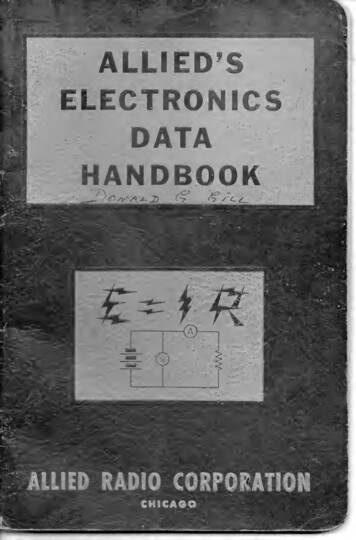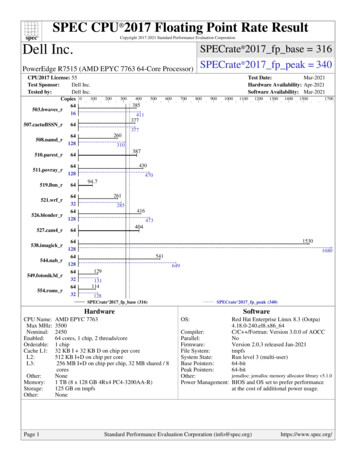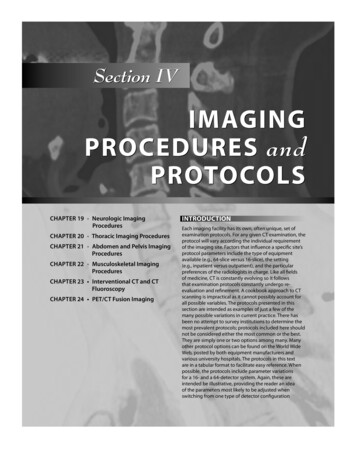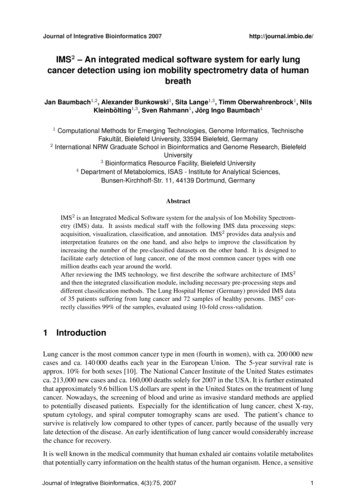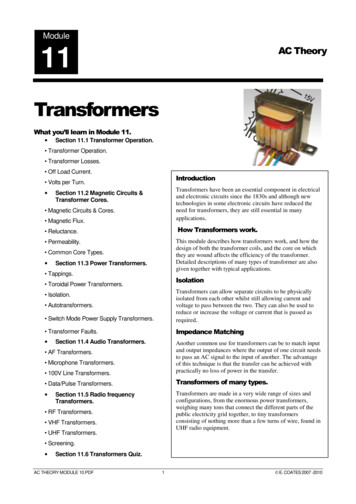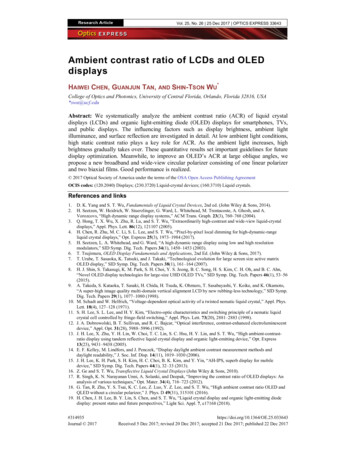
Transcription
Vol. 25, No. 26 25 Dec 2017 OPTICS EXPRESS 33643Ambient contrast ratio of LCDs and OLEDdisplaysHAIWEI CHEN, GUANJUN TAN, AND SHIN-TSON WU*College of Optics and Photonics, University of Central Florida, Orlando, Florida 32816, USA*swu@ucf.eduAbstract: We systematically analyze the ambient contrast ratio (ACR) of liquid crystaldisplays (LCDs) and organic light-emitting diode (OLED) displays for smartphones, TVs,and public displays. The influencing factors such as display brightness, ambient lightilluminance, and surface reflection are investigated in detail. At low ambient light conditions,high static contrast ratio plays a key role for ACR. As the ambient light increases, highbrightness gradually takes over. These quantitative results set important guidelines for futuredisplay optimization. Meanwhile, to improve an OLED’s ACR at large oblique angles, wepropose a new broadband and wide-view circular polarizer consisting of one linear polarizerand two biaxial films. Good performance is realized. 2017 Optical Society of America under the terms of the OSA Open Access Publishing AgreementOCIS codes: (120.2040) Displays; (230.3720) Liquid-crystal devices; (160.3710) Liquid crystals.References and 19.D. K. Yang and S. T. Wu, Fundamentals of Liquid Crystal Devices, 2nd ed. (John Wiley & Sons, 2014).H. Seetzen, W. Heidrich, W. Stuerzlinger, G. Ward, L. Whitehead, M. Trentacoste, A. Ghosh, and A.Vorozcovs, “High dynamic range display systems,” ACM Trans. Graph. 23(3), 760–768 (2004).Q. Hong, T. X. Wu, X. Zhu, R. Lu, and S. T. Wu, “Extraordinarily high-contrast and wide-view liquid-crystaldisplays,” Appl. Phys. Lett. 86(12), 121107 (2005).H. Chen, R. Zhu, M. C. Li, S. L. Lee, and S. T. Wu, “Pixel-by-pixel local dimming for high-dynamic-rangeliquid crystal displays,” Opt. Express 25(3), 1973–1984 (2017).H. Seetzen, L. A. Whitehead, and G. Ward, “A high dynamic range display using low and high resolutionmodulators,” SID Symp. Dig. Tech. Papers 34(1), 1450–1453 (2003).T. Tsujimura, OLED Display Fundamentals and Applications, 2nd Ed. (John Wiley & Sons, 2017).T. Urabe, T. Sasaoka, K. Tatsuki, and J. Takaki, “Technological evolution for large screen size active matrixOLED display,” SID Symp. Dig. Tech. Papers 38(1), 161–164 (2007).H. J. Shin, S. Takasugi, K. M. Park, S. H. Choi, Y. S. Jeong, B. C. Song, H. S. Kim, C. H. Oh, and B. C. Ahn,“Novel OLED display technologies for large-size UHD OLED TVs,” SID Symp. Dig. Tech. Papers 46(1), 53–56(2015).A. Takeda, S. Kataoka, T. Sasaki, H. Chida, H. Tsuda, K. Ohmuro, T. Sasabayashi, Y. Koike, and K. Okamoto,“A super-high image quality multi-domain vertical alignment LCD by new rubbing-less technology,” SID Symp.Dig. Tech. Papers 29(1), 1077–1080 (1998).M. Schadt and W. Helfrich, “Voltage-dependent optical activity of a twisted nematic liquid crystal,” Appl. Phys.Lett. 18(4), 127–128 (1971).S. H. Lee, S. L. Lee, and H. Y. Kim, “Electro-optic characteristics and switching principle of a nematic liquidcrystal cell controlled by fringe-field switching,” Appl. Phys. Lett. 73(20), 2881–2883 (1998).J. A. Dobrowolski, B. T. Sullivan, and R. C. Bajcar, “Optical interference, contrast-enhanced electroluminescentdevice,” Appl. Opt. 31(28), 5988–5996 (1992).J. H. Lee, X. Zhu, Y. H. Lin, W. Choi, T. C. Lin, S. C. Hsu, H. Y. Lin, and S. T. Wu, “High ambient-contrastratio display using tandem reflective liquid crystal display and organic light-emitting device,” Opt. Express13(23), 9431–9438 (2005).E. F. Kelley, M. Lindfors, and J. Penczek, “Display daylight ambient contrast measurement methods anddaylight readability,” J. Soc. Inf. Disp. 14(11), 1019–1030 (2006).J. H. Lee, K. H. Park, S. H. Kim, H. C. Choi, B. K. Kim, and Y. Yin, “AH-IPS, superb display for mobiledevice,” SID Symp. Dig. Tech. Papers 44(1), 32–33 (2013).Z. Ge and S. T. Wu, Transflective Liquid Crystal Displays (John Wiley & Sons, 2010).R. Singh, K. N. Narayanan Unni, A. Solanki, and Deepak, “Improving the contrast ratio of OLED displays: Ananalysis of various techniques,” Opt. Mater. 34(4), 716–723 (2012).G. Tan, R. Zhu, Y. S. Tsai, K. C. Lee, Z. Luo, Y. Z. Lee, and S. T. Wu, “High ambient contrast ratio OLED andQLED without a circular polarizer,” J. Phys. D 49(31), 315101 (2016).H. Chen, J. H. Lee, B. Y. Lin, S. Chen, and S. T. Wu, “Liquid crystal display and organic light-emitting diodedisplay: present status and future perspectives,” Light Sci. Appl. 7, e17168 (2018).#314935Journal 2017https://doi.org/10.1364/OE.25.033643Received 5 Dec 2017; revised 20 Dec 2017; accepted 21 Dec 2017; published 22 Dec 2017
Vol. 25, No. 26 25 Dec 2017 OPTICS EXPRESS 3364420. C. W. Tang and S. A. VanSlyke, “Organic electroluminescent diodes,” Appl. Phys. Lett. 51(12), 913–915(1987).21. H. J. Yun, M. H. Jo, I. W. Jang, S. H. Lee, S. H. Ahn, and H. J. Hur, “Achieving high light efficiency and fastresponse time in fringe field switching mode using a liquid crystal with negative dielectric anisotropy,” Liq.Cryst. 39(9), 1141–1148 (2012).22. DisplayMate Technologies Corp, http://www.displaymate.com/23. R. M. Soneira, Tablet and Smartphone Displays under Bright Ambient Lighting Shoot-Out Master Photo Gridfor Viewing Screen Shots of all the Displays (DisplayMate Technologies Corp., 2012).24. H. Chen, R. Zhu, K. Käläntär, and S. T. Wu, “Quantum dot-enhanced LCDs with wide color gamut and broadangular luminance distribution,” SID Symp. Dig. Tech. Papers 47(1), 1413–1416 (2016).25. H. Chen, G. Tan, M. C. Li, S. L. Lee, and S. T. Wu, “Depolarization effect in liquid crystal displays,” Opt.Express 25(10), 11315–11328 (2017).26. R. M. Soneira. iPhone X OLED Display Technology Shoot-Out. DisplayMate Technologies Corp., 2017.27. G. Walker, GD-Itronix Dynavue Technology. The Ultimate Outdoor-Readable Touch-Screen Display (RuggedPC Review, 2007).28. N. Y. Kim, Y. B. Son, J. H. Oh, C. K. Hwangbo, and M. C. Park, “TiNx layer as an antireflection and antistaticcoating for display,” Surf. Coat. Tech. 128, 156–160 (2000).29. S. R. Kennedy and M. J. Brett, “Porous broadband antireflection coating by glancing angle deposition,” Appl.Opt. 42(22), 4573–4579 (2003).30. H. K. Raut, V. A. Ganesh, A. S. Nair, and S. Ramakrishna, “Anti-reflective coatings: A critical, in-depthreview,” Energy Environ. Sci. 4(10), 3779–3804 (2011).31. G. Tan, J. H. Lee, Y. H. Lan, M. K. Wei, L. H. Peng, I. C. Cheng, and S. T. Wu, “Broadband antireflection filmwith Moth-eye-like structure for flexible display application,” Optica 4(7), 678–683 (2017).32. P. de Greef and H. G. Hulze, “Adaptive dimming and boosting backlight for LCD-TV Systems,” SID Symp.Dig. Tech. Papers 38(1), 1332–1335 (2007).33. C. C. Lai and C. C. Tsai, “Backlight power reduction and image contrast enhancement using adaptive dimmingfor global backlight applications,” IEEE Trans. Consum. Electron. 54(2), 669–674 (2008).34. H. Chen, T. H. Ha, J. H. Sung, H. R. Kim, and B. H. Han, “Evaluation of LCD local-dimming-backlightsystem,” J. Soc. Inf. Disp. 18(1), 57–65 (2010).35. K. Müllen and U. Scherf, Organic Light Emitting Devices: Synthesis, Properties and Applications (John Wiley& Sons, 2006).36. B. C. Kim, Y. J. Lim, J. H. Song, J. H. Lee, K. U. Jeong, J. H. Lee, G. D. Lee, and S. H. Lee, “Widebandantireflective circular polarizer exhibiting a perfect dark state in organic light-emitting-diode display,” Opt.Express 22(107), A1725–A1730 (2014).37. A. Uchiyama and T. Yatabe, “Characteristics and applications of new wide-band retardation films,” SID Symp.Dig. Tech. Papers 32(1), 566–569 (2001).38. N. Koma, M. Hashizume, M. Yamamoto, and Y. Sato, “Development of photochromic circular polarizer forOLEDs,” SID Symp. Dig. Tech. Papers 43(1), 1268–1271 (2012).39. Y. Takahashi, Y. Furuki, S. Yoshida, T. Otani, M. Muto, Y. Suga, and Y. Ito, “A new achromatic quarter-wavefilm using liquid-crystal materials for anti-reflection of OLEDs,” SID Symp. Dig. Tech. Papers 45(1), 381–384(2014).40. Q. Hong, T. X. Wu, R. Lu, and S. T. Wu, “Wide-view circular polarizer consisting of a linear polarizer and twobiaxial films,” Opt. Express 13(26), 10777–10783 (2005).1. IntroductionContrast ratio (CR) is a key display metric to achieve supreme image quality [1–4],especially, to enable high dynamic range (HDR) [2, 5]. For an emissive display, like organiclight-emitting diode (OLED), its CR can approach 1,000,000:1 or even higher [6–8]. Whereasfor a non-emissive liquid crystal display (LCD), its CR is limited due to the depolarizationeffects from thin film transistors, LC layer, and color filters. For example, the CR of acommercial multi-domain vertical alignment (MVA) LCD TV is about 5000:1 [9]. For otherLCD modes, such as twisted nematic [10] and fringe field switching [11], it is about 2000:1.As a result, it is generally perceived that OLED shows much better performance than LCD interms of contrast ratio. This is true at dark ambient. However, in reality, no matter indoor oroutdoor, ambient light is inevitable. Thus, how these two display technologies perform underdifferent ambient lighting conditions is a practically important concern.To evaluate a display’s performance in the presence of ambient light, a metric calledambient contrast ratio (ACR) should be considered for real working scenarios [12–15]. Infact, ACR has already been widely used to evaluate the sunlight readability of transflectiveLCDs [16]. Recently, this concept is also extended to OLED displays [17–19]. But a detailedcomparison between LCD and OLED has not been reported. Also, most of previous studies
Vol. 25, No. 26 25 Dec 2017 OPTICS EXPRESS 33645focused on the ACR at normal viewing direction. For a wide-view display such as TV, ACRat oblique angles is equally important.In this paper, we perform a systematic analysis about ACR for both LCD and OLED.Three applications are emphasized: mobile displays, TVs, and public displays. Theinfluencing factors like display brightness, ambient light illuminance, and surface reflectionare investigated in detail. Also, the ambient isocontrast contour is plotted for the first time. Itreveals quantitative information about LCD/OLED performance at all viewing directions.Through our analyses, we find high static contrast ratio plays a key role in low ambient lightconditions. As the ambient light increases, higher display brightness takes over. This findingsets important guidelines for future display optimization.2. Modeling of ambient contrast ratioAs mentioned earlier, ambient contrast ratio (ACR) is an important parameter toquantitatively evaluate a display performance. It is generally defined as [12, 17]:ACR Lon Lambient RL,Loff Lambient RL(1)where Lon (Loff) represents the on-state (off-state) luminance value of an LCD or OLED, andLambient is ambient luminance. Mostly, illuminance (unit: lux) is used to quantify the ambientlight. Here, to be compatible with display luminance (unit: nits), we convert the illuminanceto luminance by dividing a factor of π in Eq. (1) [16]. Another parameter RL in Eq. (1) is theluminous reflectance of the display panel. It is defined as [17]:λ2RL λ V (λ ) S (λ ) R (λ ) d λ1λ2 λV ( λ ) S (λ ) d λ,(2)1where V(λ) is the photopic human eye sensitivity function, R(λ) is the spectral reflectance ofthe display device, and S(λ) is the spectrum of the ambient light (CIE standard D65 source isused in this work). Thus, the obtained ACR hereafter is not for a single wavelength; instead, itis for the whole visible region. Next, we will model the ACR of LCD and OLED separately,as they exhibit quite different device configurations. Please note that here we use the samedefinition of ACR [Eq. (1)] to establish our simulation model, but with two improvements: 1)we extend this concept to different viewing angles, and 2) we also consider the light leakagefrom the employed circular polarizer for OLED displays. Details will be discussed later.2.1 ACR of an LCDFig. 1. Schematic diagram of an LCD.Figure 1 shows the schematic diagram of an LCD, where the main reflections occur at thefront surface of display device, denoted as R1. The ambient light entering LCD panel is
Vol. 25, No. 26 25 Dec 2017 OPTICS EXPRESS 33646mostly absorbed by the crossed polarizers and other optical components. As a result, weassume no light is reflected back. Then its ACR can be described as:ACRLCD (θ , φ ) Lon (θ , φ ) R1,Loff (θ , φ ) R1(3)R1 Lambient RL surface (θ , φ ).Here, we try to simulate the ACR for the entire viewing zone. Therefore, θ and φ are chosento represent the polar angle and azimuthal angle, respectively.2.2 ACR of an OLEDUnlike LCD, OLED uses metal (e.g. Ag or Al) as the cathode electrode; hence, OLED itselfis a highly reflective device [6, 20]. To block the reflected light from cathode, a broadbandcircular polarizer is commonly used, as shown in Fig. 2. However, this broadband circularpolarizer (consisting of a linear polarizer, a half-wave plate, and a quarter-wave plate) workswell only at normal angle. At large oblique angles, the light leakage (denoted as CPleak) isrelatively severe, as will be discussed later. Thus, in addition to the surface reflection, thelight leakage from circular polarizer should be considered as well for OLED:ACROLED (θ , φ ) Lon (θ , φ ) R1 R2,Loff (θ , φ ) R1 R2R 1 Lambient RL surface (θ , φ ),(4)R2 Lambient [1 RL surface (θ , φ )] RL OLED (θ , φ ) CPleak (θ , φ ).Fig. 2. Schematic diagram of an OLED.3. Simulation resultsWith the introduction of ACR for both LCD and OLED, now we could perform thecalculations. Firstly, we investigate how ACR changes as a function of ambient light. Thenwe focus on the ACR at different viewing angles, represented by ambient isocontrast contour.In our simulations, three different display applications: mobile displays, large-sized TVs, andpublic displays, are considered separately. Please be reminded that both LCD and OLEDtechnologies are still advancing rapidly. Especially for OLED, its efficiency has beenimproved noticeably in the past three decades [19]. Therefore, to make a fair comparison, wemainly focus on the state-of-the-art LCD and OLED displays as examples.3.1 Simulated ACRa) Mobile displaysIn this category, we choose smartphone as an example to do the comparison. For touch screenoperations, normally anti-reflection (AR) coating is not used. As a result, the outer surface of
Vol. 25, No. 26 25 Dec 2017 OPTICS EXPRESS 33647display is a cover glass. Here, we assume it is BK-7. By calculation using Eq. (2), thecorresponding luminous reflectance at normal angle RL(0 , 0 ) is 4.2%. For an LCDsmartphone, fringe field switching (FFS) mode with negative dielectric anisotropy LCmixture (Δε 0) is commonly used [10, 21]. Its CR is assumed to be 2000:1, with peakbrightness 600 nits. While for OLED, we assume its peak brightness is also 600 nits, and CRis assumed to be 1,000,000:1. Then we calculate the ACR at different ambient lightconditions. Results are plotted in Fig. 3.As expected, when the ambient light is weak, OLED shows a much higher ACR thanLCD. But as the ambient light gets stronger, two ACR curves get much closer. At 300 lux(moderate indoor lighting), LCD shows comparable ACR to OLED (140.1 vs. 150.6). If weslightly increase the peak brightness of LCD (by increasing the backlight intensity) to 800nits, two ACR curves crossover at 90 lux (typical lighting condition in office buildinghallway or toilet lighting). It means below 90 lux, OLED (with 600 nits of peak brightness)exhibits a higher ACR, but beyond 90 lux the situation is reversed for the LCD with 800 nitsof peak brightness.Fig. 3. Calculated ACR as a function of different ambient light conditions for LCD and OLEDsmartphones. Here, we assume LCD peak brightness is 600/800 nits and OLED peakbrightness is 600 nits, and the surface reflectance is 4.2% for both LCD and OLED.Table 1. Comparison between measured ACR and calculated ACR.iPhone XGalaxy Note8Galaxy S8iPhone 7iPhone 6DisplaytypeFull brightness(nits)*StaticCRSurfacereflectionMeasured ACR fromDisplayMate**CalculatedACR usingEq. 27.9LCD5581592:14.6%121113.7* This brightness is measured for a screen that is entirely all white with 100% Average Picture Level. Autobrightness is not considered here.** This ACR is measured with a light source that uniformly illuminates the displays from all directions with314 lux, which corresponds to 100 nits in calculation.
Vol. 25, No. 26 25 Dec 2017 OPTICS EXPRESS 33648As discussed above, higher brightness is more critical for higher ACR. This is alsoverified by experimental results, as listed in Table 1. These testing results are obtained fromDisplayMate Technologies Corp [22]. They use a light source to uniformly illuminate thedisplays from all directions, then measure the screen brightness and screen reflectance to getACR (they call it contrast rating for high ambient light: CR HAL). More details could befound in [23]. From Table 1, iPhone X has the highest peak brightness, thus leading to thehighest ACR. Also, it is found that our calculated ACR shows excellent agreement with themeasured results. The validity of our model is therefore confirmed.b) Large-sized TVsFor large-sized TVs, they are mostly operated by remote control, so that no touchfunctionality is needed. As a result, an AR coating is commonly adopted. Let us assume asingle-layer AR coating with magnesium fluoride (MgF2) is used, and its luminousreflectance at normal angle is RL(0 , 0 ) 1.5% [17]. Also, TVs are powered by an electricaloutlet. Thus, their peak brightness can be boosted compared to the battery-drivensmartphones. Nowadays, the state-of-the-art LCD TV has 1500 nits of peak brightness,while OLED has 800 nits. In terms of static CR, MVA LCD is assumed to be 5000:1, whileOLED is 1,000,000:1. With all these information, we can get ACR for both LCD and OLEDTVs. Similarly, as shown in Fig. 4, OLED exhibits a higher ACR in the low illuminanceregion (dark room), but declines sharply as ambient light gets brighter. At 72 lux, OLEDshows the same ACR as LCD. Beyond that, LCD is better. Again, this 72 lux is obtainedbased on the current LCD and OLED peak brightness (1500 nits vs. 800 nits). As bothtechnologies continue to evolve, the crossover point will undoubtedly change with time.Fig. 4. Calculated ACR as a function of different ambient light conditions for LCD and OLEDTVs. Here we assume LCD peak brightness is 1500 nits and OLED peak brightness is 800 nits,and the surface reflectance is 1.5% for both LCD and OLED.c) Public displaysRecently, public display is emerging rapidly [24]. They have potential applications foradvertisement, entertainment, and education, etc. For such displays, they have to endure veryharsh environments, including very strong ambient light, or even direct sunlight. As a result,the display brightness has to be improved substantially; otherwise, the displayed imageswould be washed out. Currently, the LCD intended for public displays can get 2500 nits. Letus assume OLED public display can get 1200 nits. We can also boost the brightness for
Vol. 25, No. 26 25 Dec 2017 OPTICS EXPRESS 33649OLED, but the tradeoffs are burn-in and compromised lifetime. As Fig. 5 shows, thecrossover point of ACR takes place at 96.7 nits. For an overcast day, the ambient lightilluminance is at least 1000 lux. It means for public displays, LCD is favored for most cases.Fig. 5. Calculated ACR as a function of different ambient light conditions for LCD and OLEDpublic displays. Here we assume LCD peak brightness is 2500 nits and OLED peak brightnessis 1200 nits, and the surface reflectance is 1.5% for both LCD and OLED.3.2 Simulated ambient isocontrast contourSo far, we concentrate on the ACR at normal angle. Next, we examine the ACR at differentviewing angles. Before that, we have to elucidate the device parameters for both LCD andOLED. As discussed above, two LCD modes are used in our simulation: n-FFS for smartphones, and MVA for TVs and public displays. For both LCD modes, the parameters are thesame as reported in [25]. Basically, the polarizer and analyzer are 24 µm thick with no 1.5,ko 0.000306, ne 1.5, and ke 0.019027. Compensation films are implemented to suppressthe color shift and gamma shift at large oblique angles. Also, their depolarization effect isconsidered to better present the real cases [25].For OLED, as mentioned earlier, a broadband circular polarizer consisting of a linearpolarizer, a half-wave plate, and a quarter-wave plate is used. Its optical configuration isplotted in Fig. 6(a). The parameter of linear polarizer is the same as that used in LCD. For thehalf-wave plate, it is 183.33 µm thick positive A-film with no 1.5095 and ne 1.511 at 550nm. The quarter-wave plate is using the same A-film, but with reduced thickness 91.67 µm.Then we calculate its light leakage at different wavelengths and different angles using acommercial simulation software TechWiz LCD (Sanayi-system, Korea). In our simulation,the OLED is replaced with a reflector. Figures 6(b) and 6(c) show the calculated results. Atnormal angle, the light leakage is less than 1% in the visible region (450 nm – 700 nm), thebroadband feature is indeed validated. As the viewing angle increases, light leakage graduallyincreases and reaches up to almost 40%. This will undoubtedly affect the final perceivedACR at oblique viewing directions.
Vol. 25, No. 26 25 Dec 2017 OPTICS EXPRESS 33650Fig. 6. (a) Schematic diagram of optical configuration of broadband circular polarizer; (b)Calculated light leakage at different wavelengths at normal angle (θ 0 , φ 0 ); and (c)Calculated light leakage at different polar angles (φ 0 ).In the above calculations for light leakage, OLED is assumed to be a perfect mirror. But tomake it more accurate, we have to know the real reflectance of OLED panel, which is RL OLEDin Eq. (4). Here, a typical multi-layer OLED device is considered, and the home-madeMATALB codes are employed to calculate the angular-dependent luminous reflectance. Moresimulation details could be found in our previous paper [18]. Figure 7 shows the simulatedresults. It is seen that for the whole viewing zone, the obtained luminance reflectance doesn’tchange much ( 80%). Please note, for different OLED structures, this reflectance may varydue to the strong interference/cavity effect.Fig. 7. Calculated angular-dependent luminous reflectance of a multi-layer OLED device.a) Mobile displaysAgain, we use n-FFS based LCD to compare with OLED smartphone. Both LCD and OLEDare assumed to have the same peak brightness, which is 600 nits. BK-7 is used as the coverglass. Figure 8(a) shows the calculated luminous reflectance of BK-7 at different viewing
Vol. 25, No. 26 25 Dec 2017 OPTICS EXPRESS 33651directions. When the polar angle is less than 45 , RL remains lower than 5%. But it increasessharply as viewing angle further increases. Another thing worth mentioning here is thedecreased brightness. For OLED, it is self-emissive and its angular distribution is muchbroader than LCD. For instance, at 30 viewing angle, OLED brightness only decreases by 20%, whereas LCD brightness decreases more than 50% [26].Fig. 8. (a) Calculated luminous reflectance of BK-7 cover glass at different angles, and (b)normalized brightness of LCD and OLED smartphones.Fig. 9. Simulated ambient isocontrast contour for (a) LCD smartphone at 500 lux, whereACRmax 86.1:1, ACRmin 1.3:1, (b) OLED smartphone at 500 lux, where ACRmax 89.2:1,ACRmin 2.0:1, (c) LCD smartphone at 5000 lux, where ACRmax 9.8:1, ACRmin 1.1:1, and(b) OLED smartphone at 5000 lux, where ACRmax 9.8:1, ACRmin 1.1:1. Both LCD andOLED are assumed to have the same peak brightness: 600 nits.
Vol. 25, No. 26 25 Dec 2017 OPTICS EXPRESS 33652With all these information, we calculate the ambient isocontrast contour for both LCD andOLED. At 500 lux (office lighting), it is interesting to see LCD [Fig. 9(a)] and OLED [Fig.9(b)] show quite similar contour patterns. In theory, OLED has a broader angular distribution,which is supposed to perform better at large angles. However, this advantage is evened outdue to the light leakage of circular polarizer. Also, from these two figures, most of theviewing zone shows ACR 5:1, which is adequate for normal reading. As the ambient lightincreases to 5000 lux (outdoor with moderate overcast sky), LCD and OLED show muchreduced but still quite similar ACR pattern. According to the analysis in [16, 27], ACR 2means display is unreadable. Therefore, from Figs. 9(c) and 9(d), the viewing zone for LCDand OLED is limited to 50 in an overcast day.b) Large-sized TVsTo apply an AR coating for TVs, multiple approaches can be employed [28–31]. Currently, asingle-layer magnesium fluoride (MgF2) AR coating is a favored choice due to its simpleconfiguration, low cost and fairly good performance [17]. Figure 10(a) shows the calculatedluminous reflectance of AR-coated BK-7 at different angles. Within 45 , the RL value is lowerthan 2%, which is about 2.5x lower than that of a bare BK-7 glass. Also, the decreasedbrightness for LCD and OLED is considered, as shown in Fig. 10(b). Unlike smartphones,wide view is more critical for TVs, aiming at multi-viewers applications. As a result, thebrightness distribution is broader, e.g. OLED brightness decrease at 30 is less than 10%,while LCD is 35%.Fig. 10. (a) Calculated luminous reflectance of AR-coated BK-7 cover glass at different angles,and (b) normalized brightness of LCD and OLED TVs.Figure 11 depicts the ambient isocontrast contour under 50 lux of ambient light (a typicallighting condition in living rooms). From Fig. 11, firstly, both LCD and OLED can getreasonably good performance (ACR 50:1) at almost entire viewing zone ( 80 ). Then inthe central region, LCD shows superior ACR than OLED. For example, ACR 1000 hasbeen extended to over 40 in LCD panel; whereas for OLED, it is limited to 30 . This ismainly because LCD exhibits a much higher peak brightness than OLED (1500 nits vs. 800nits).
Vol. 25, No. 26 25 Dec 2017 OPTICS EXPRESS 33653Fig. 11. Simulated ambient isocontrast contour for (a) LCD TV at 50 lux, where ACRmax 2931.3:1, ACRmin 16.2:1, and (b) OLED TV at 50 lux, where ACRmax 3362.2:1, ACRmin 27.8:1. The peak brightness for LCD is 1500 nits and for OLED is 800 nits.c) Public displaysFor public displays, we assume the AR coating and brightness distribution for LCD andOLED remain the same as those shown in Fig. 10; the only difference is their peak brightnessis 2500 nits for LCD and 1200 nits for OLED. Here, ambient light is also much stronger thanany other case discussed above: 10,000 lux to represent full day light (not direct sun). FromFig. 12, LCD exhibits great advantages over OLED. Firstly, its maximum ACR is over 2xhigher than that of OLED: 61.2 vs. 29.5. Secondly, LCD’s ACR is more than 5:1 within the60 viewing cone, while OLED’s is only 40 . This means, LCD exhibits a better sunlightreadability. Lastly, LCD’s viewing zone with ACR 2:1 is as large as 75 . These resultsclearly indicate that display brightness plays the key role for improving sunlight readability.Fig. 12. Simulated ambient isocontrast contour for (a) LCD public display at 10,000 lux, whereACRmax 61.2:1, ACRmin 1.2:1, and (b) OLED public display at 10,000 lux, where ACRmax 29.5:1, ACRmin 1.2:1. The peak brightness for LCD is 2500 nits and for OLED is 1200 nits.
Vol. 25, No. 26 25 Dec 2017 OPTICS EXPRESS 336544. DiscussionFrom the above discussions, we can tell ACR is jointly determined by several factors, likedisplay brightness, ambient light illuminance, surface reflection, and light leakage, etc. Toimprove ACR, LCD and OLED camps should have different strategies.4.1 Enhancing an LCD’s ACRFor an LCD, high brightness is its major strength, leading to an excellent ACR, especially atstrong ambient light conditions. But under low ambient light, LCD has room forimprovement. The key is to suppress the light leakage at voltage-off state. Recently, an LCDpanel with in-cell polarizer was proposed to decouple the depolarization effect of LC layerand color filter array [25]. The CR of a MVA LCD TV could be boosted to 20,000:1. Also, adual-panel LCD system is proposed to further enhance the CR to more than 1,000,000:1 [4].Fig. 13. Simulated ambient isocontrast contour for (a) conventional LCD TV at 50 lux, whereACRmax 2931.3:1, ACRmin 16.2:1, and (b) new LCD TV with mini-LED backlight at 50 lux,where ACRmax 7312.5:1, ACRmin 18.8:1.Another option is to use local dimming [32–34]. In theory, its CR can approach infinity toone, as long as all LEDs are turned off. Especially, when mini-LED technology (LED chipsize is 100-200 μm) is getting mature, dimming number and accuracy will be improvedsignificantly. Here, we compare the viewing angle performance between conventional LCDand mini-LED-enhanced LCD. Their ambient isocontrast contours are plotted in Fig. 13. Withthe help of mini-LED, LCD TV can get over 2x higher ACR at normal direction (7312.5 vs.2931.3). Besides, its high ACR region is widened. For example, ACR 2000:1 is expandedto almost 50 . For conventional LCD, it is only 30 .4.2 Enhancing an OLED’s ACRFor an OLED, it shows inherent true black state, leading to an excellent ACR at dark ambient.But this advantage gradually disappears as the ambient light increases, due to the inadequatebrightness. To improve that, it needs substantial improvement on OLED materials and deviceconfigurations [19, 35]. Another limiting factor is the employed circular polarizer. Throughour analysis, this polarizer is broadband but not wide view. Light leakage as high as 40%exists at large oblique angles. To suppress light leakage, the Nz value ( nx-nz/nx-ny, where nx,ny, and nz are the refractive in
outdoor, ambient light is inevitable. Thus, how these two display technologies perform under different ambient lighting conditions is a practically important concern. To evaluate a display’s performance in the presence of ambient light, a metric called ambient contrast ratio (ACR) sh
